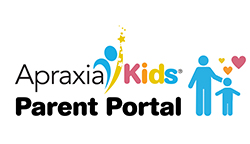It is critical in therapy that multi-sensory cues be used to facilitate sound production and sound sequencing in children with apraxia of speech. As coined by Sharon Gretz, parent of a child with apraxia of speech, these cues serve as “anchors” for the child. By providing anchors through verbal and visual prompts, the child can more readily find the correct starting positions and more accurately move through sequences of sounds. Although sign language, touch cues, visual prompts, and picture stimuli foster verbal speech production, the primary goal is to fade these cues as soon as possible to allow for the child’s speech motor system to “take over.”
By providing multiple cues, the therapist has the opportunity to gradually fade the cues in small steps, assuring success for the child in using his/her own verbal skill. For example, if the sign for “more” is used along with the word “more,” the therapist can fade to the sign plus the “mm” sound cue; to the sign plus the visual lip position for “m”; to the sign by itself; and finally to a question prompt. This also facilitates movement away from simple, immediate verbal imitation. Although a necessary initial strategy, if the child comes to rely just on direct imitation, the likelihood of more rapid development of the targeted speech motor patterns decreases. I have often seen children who wait for the entire verbal stimulus before attempting a word, despite long-term therapy intervention. Of course, this depends on the familiarity with the targeted word, but if the child has demonstrated consistent success on direct verbal imitation, challenging the child by fading verbal cues should be encouraged.
Sign language should be seen primarily as a prompt for verbal speech. The reason that I like signing is that it can be brought close to the face to better assure that the child also focuses on oral cues provided. It is, of course, beneficial if the child is able to use signing to facilitate communication success as he/she works on verbal speech production. However, if it becomes too cumbersome for the child, it may be counterproductive. The therapist should not stop using sign language because of this, but continue its use as a prompt. Too many prompts can confuse the child, especially if he/she struggles with fine motor skills, attention issues, or language processing. One child that I saw in therapy tended to self-stimulate with finger movements, and any attempt at signing increased this self-stimulation. Other children cannot put the energy and focus on both signing and speaking, but again it is not critical that the children always sign. Although relatively rare, there are situations, therefore, that signing and/or other cueing may not be facilitory. With only verbal cues available, however, progress can be quite challenging.
By David W. Hammer, M.A., CCC-SLP
updated January, 2022
